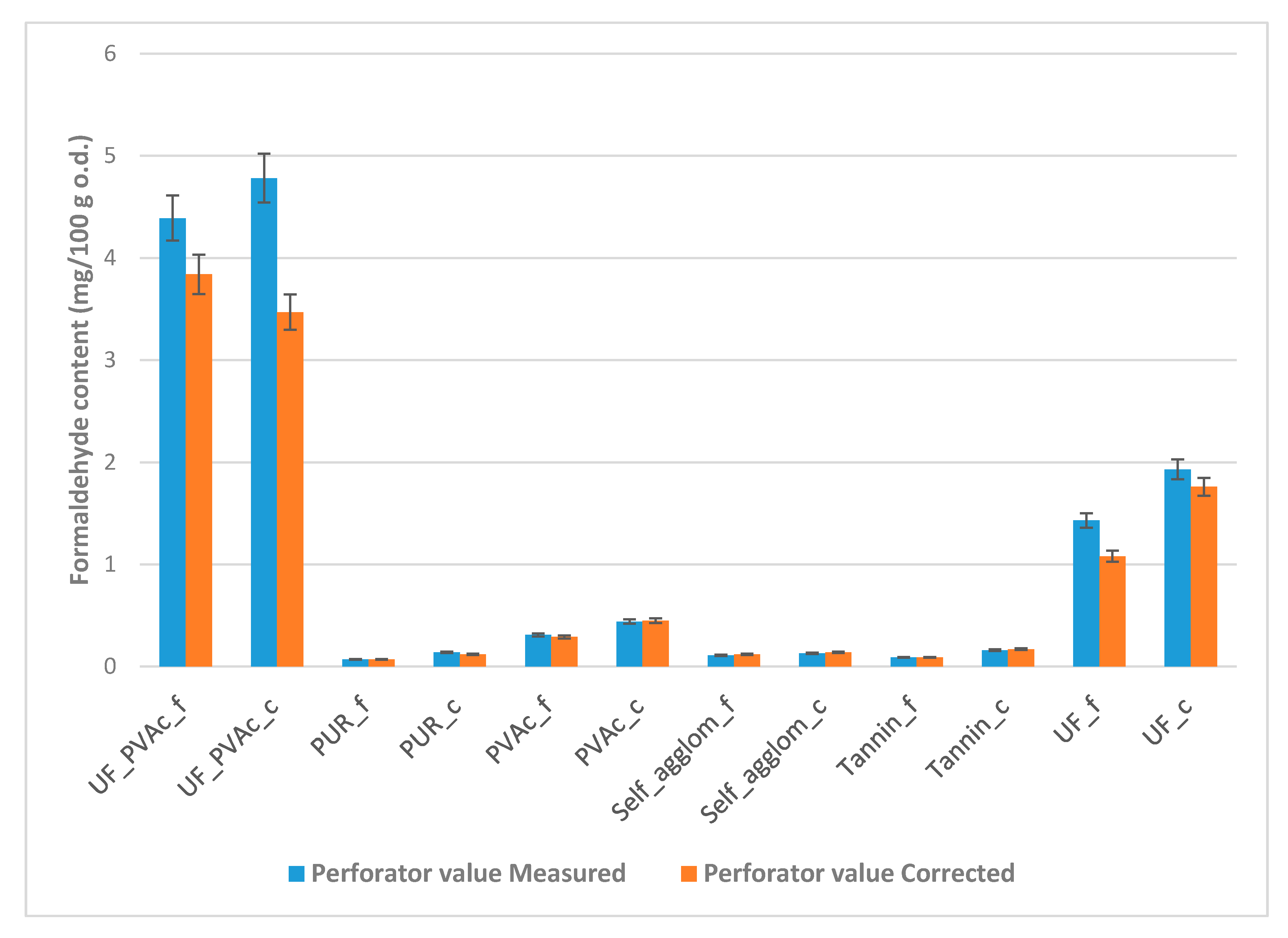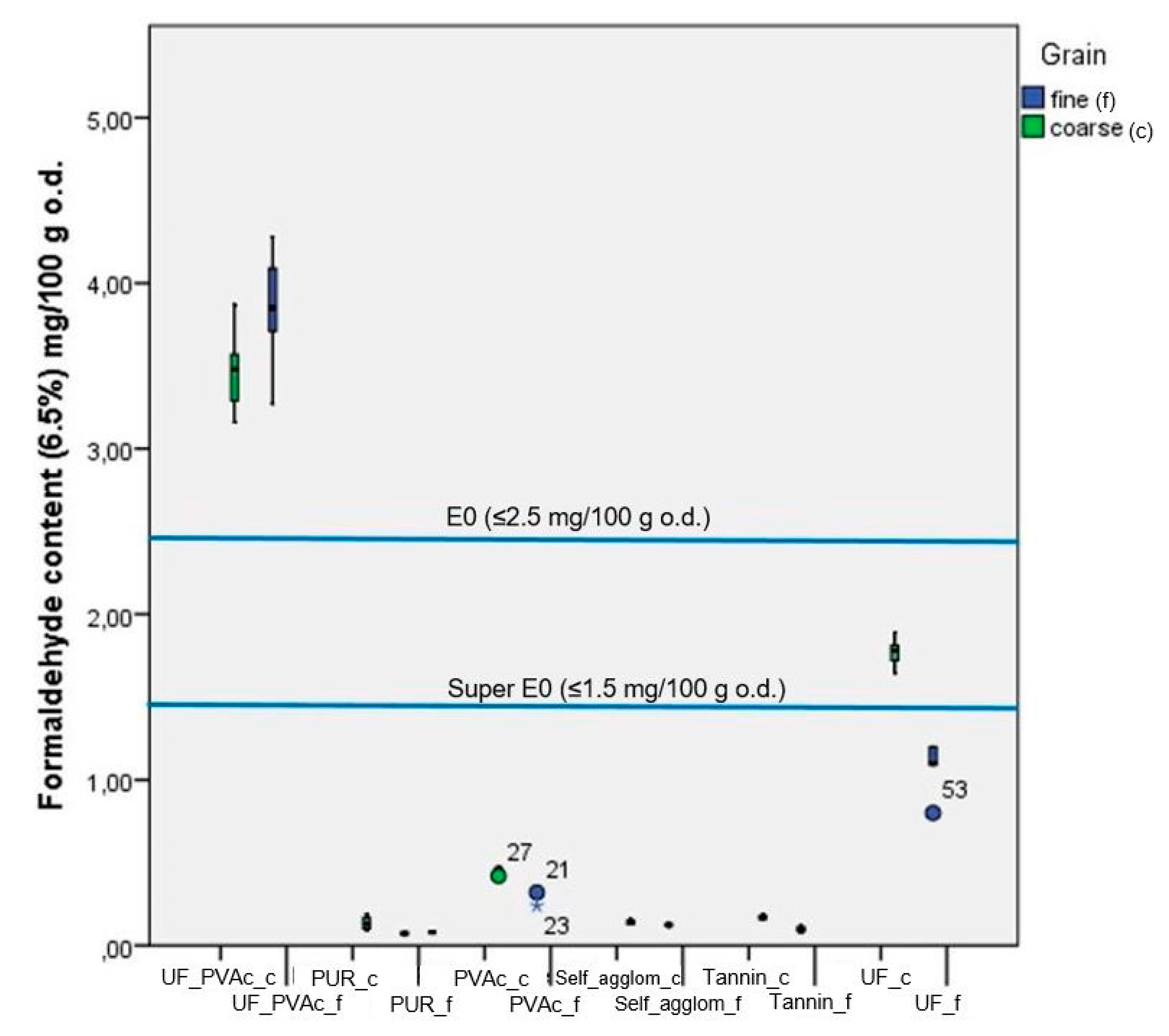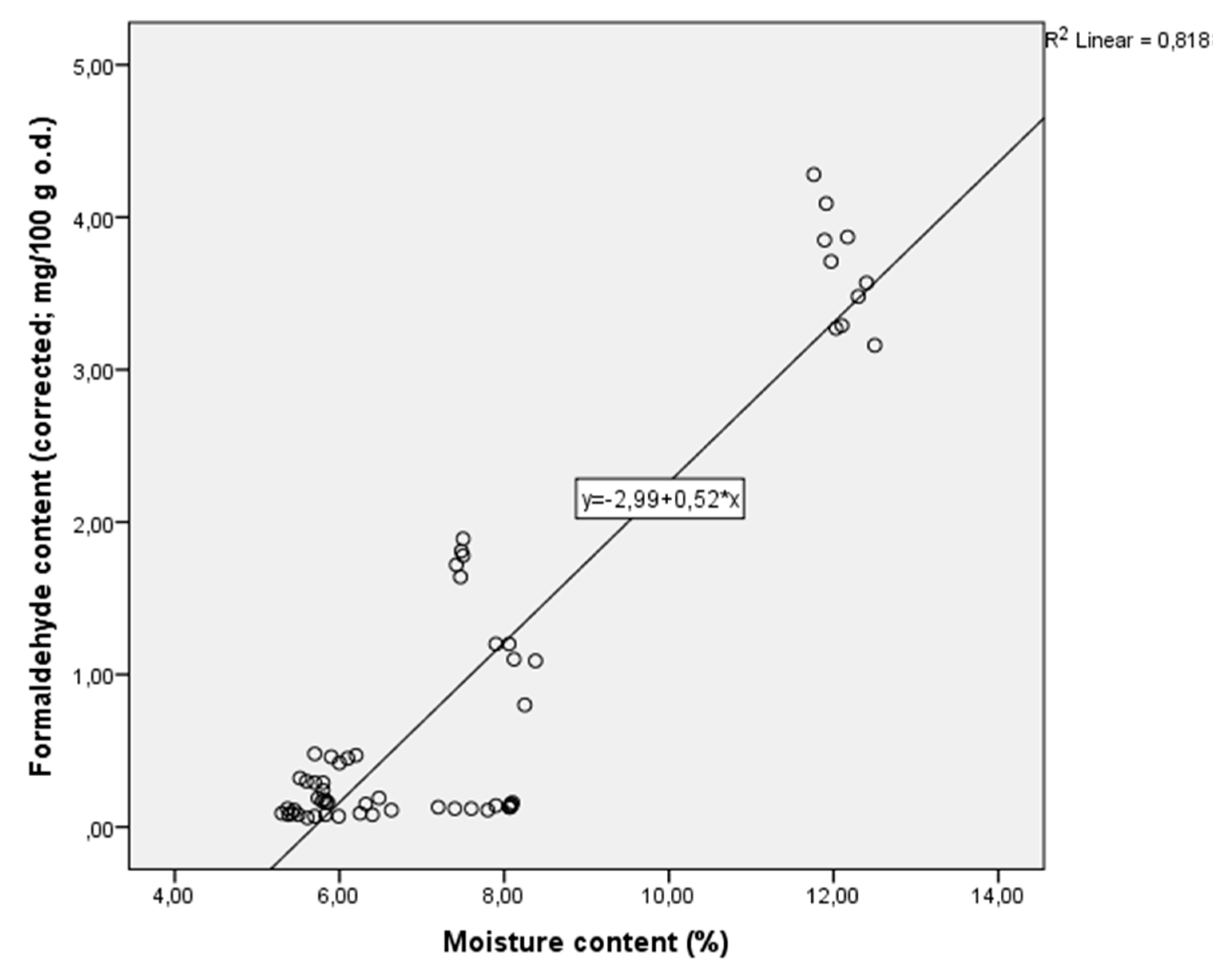Analysis of Larch-Bark Capacity for Formaldehyde Removal in Wood Adhesives
Abstract
1. Introduction
2. Materials and Methods
3. Results and Discussion
4. Conclusions
- -
- Larch bark had significant influence on the characteristics of free formaldehyde content in decorative panels. It was found that the majority of the panel samples were included in the E0 category (≤2.5 mg/100 g o.d.). The values of free formaldehyde content varied depending on the type of adhesive formulation for the board. It can be considered a significant contribution in terms of the environment.
- -
- In addition, the research identified that 75% of the test specimens bonded with tannin and PUR adhesives reached super-E0 classification (≤1.5 mg/100 g o.d.). These new classes (E0 and super-E0) of low formaldehyde emitting panels were initiated by the Japanese standards (JIS), and established by the European Panel Federation (EPF).
- -
- The multiple-regression model, calculated for all boards to observe the effect of board-moisture content and larch-bark particle fraction on formaldehyde content, indicated that moisture content is significantly correlated with free formaldehyde content, with adjusted coefficient of determination R2 = 0.812 (Y = 0.5X − 2.99). Board-moisture content had a highly significant effect (p = 0.000), while the effect of particle fraction on formaldehyde content (p = 0.806) had no statistical impact.
- -
- The bark of the selected wood species had a positive impact on free formaldehyde reduction, providing grounds for further research.
Author Contributions
Funding
Acknowledgments
Conflicts of Interest
References
- Ghaffarianhoseini, A.; AlWaer, H.; Omrany, H.; Ghaffarianhoseini, A.; Alalouch, C.; Clements-Croome, C.; Tookey, J. Sick building syndrome: Are we doing enough? Archit. Sci. Rev. 2018, 61, 99–121. [Google Scholar] [CrossRef]
- AlWaer, H.; Illsley, B. Rethinking Masterplanning: Creating Quality; Institute of Civil Engineerings, ICE Publishing: London, UK, 2017. [Google Scholar]
- Gül, H. Sick Building Syndrome from the Perspective of Occupational and Public Health. Sick Building Syndrome; Abdul-Wahab, S.A., Ed.; Springer: Berlin/Heidelberg, Germany, 2011; p. 646. [Google Scholar]
- Belachew, H.; Assefa, Y.; Guyasa, G.; Azanaw, J.; Adane, T.; Dagne, H.; Gizaw, Z. Sick building syndrome and associated risk factors among the population of Gondar town, northwest Ethiopia. Environ. Health Prev. 2018, 23, 1–9. [Google Scholar] [CrossRef]
- Funaki, K.; Fukuta, H.; Nishizawa, M.; Yamagishi, T. Adsorption of formaldehyde on the bark of Larix kaempferi. J. Nat. Med. 2004, 58, 104–108. Available online: https://ci.nii.ac.jp/naid/110008732307 (accessed on 25 November 2019).
- Curling, S.; Loxton, C.; Ormondroyd, G. A rapid method for investigating the absorption of formaldehyde from air by wool. J. Mater. Sci. 2012, 47, 3248–3251. [Google Scholar] [CrossRef]
- Teiri, H.; Pourzamzni, H.; Hajizadeh, Y. Phytoremediation of Formaldehyde from Indoor Environment by Ornamental Plants: An Approach to Promote Occupants Health. Int. J. Prev. Med. 2018, 9, 70. [Google Scholar] [CrossRef]
- Kim, K.J.; Mi, J.K.; Jeong, S.S.; Eun, H.Y.; Son, K.C.; Kays, S. Efficiency of Volatile Formaldehyde Removal by Indoor Plants: Contribution of Aerial Plant Parts versus the Root Zone. J. Am. Soc. Hortic. Sci. 2008, 133, 521–526. [Google Scholar] [CrossRef]
- Huang, K.C.; Tsay, Y.S.; Lin, F.M.; Lee, C.C.; Chang, Y.W. Efficiency and performance tests of the sorptive building materials that reduce indoor formaldehyde concentrations. PLoS ONE 2019, 14, e0210416. [Google Scholar] [CrossRef]
- Takano, T.; Murakami, T.; Kamitakahara, H.; Nakatsubo, F. Formaldehyde absorption by karamatsu (Larix leptolepsis) bark. J. Wood Sci. 2008, 54, 332–336. [Google Scholar] [CrossRef]
- Tudor, E.M.; Barbu, M.C.; Petutschnigg, A.; Réh, R. Added-Value for wood bark as a coating layer for flooring tiles. J. Clean. Prod. 2018, 170, 1354–1360. [Google Scholar] [CrossRef]
- Pasztory, Z.; Ronyecz-Mohacsine, I.; Gorbacheva, G.; Börcsök, Z. The Utilization of Tree Bark. Bioresources 2016, 11, 7859–7888. [Google Scholar] [CrossRef]
- Mikołajczak, E. Possibilities of utilizing wood biomass. Transf. Inovácií 2011, 19, 26–29. [Google Scholar]
- Sari, B.; Ayrilmis, N.; Nemli, G.; Baharoğlu, M.; Gümüşkaya, E.; Bardak, S. Effects of chemical composition of wood and resin type on properties of particleboard. Lignocellulose 2012, 1, 174–184. [Google Scholar]
- Nemli, G.; Colakoğlu, G. Effects of Mimosa Bark Usage on Some Properties of Particleboard. Turk. J. Agric. For. 2005, 29, 227–230. [Google Scholar]
- Salca, E.-A.; Hiziroglu, S. Hardness and Roughness of Overlaid Wood Composites Exposed to a High-Humidity Environment. Coatings 2019, 9, 711. [Google Scholar] [CrossRef]
- Aydin, I.; Demirkir, C.; Colak, S.; Colakoğlu, S. Utilization of bark flours as additive in plywood manufacturing. Eur. J. Wood Wood Prod. 2017, 75, 63–69. [Google Scholar] [CrossRef]
- Ružiak, I.; Igaz, R.; Krišťák, L.; Réh, R.; Mitterpach, J.; Očkajová, A.; Kučerka, M. Influence of Urea-Formaldehyde Adhesive Modification with Beech Bark on Chosen Properties of Plywood. Bioresources 2017, 12, 3250–3264. [Google Scholar] [CrossRef]
- Réh, R.; Igaz, R.; Krišťák, Ľ.; Ružiak, I.; Gajtanska, M.; Božíková, M.; Kučerka, M. Functionality of Beech Bark in Adhesive Mixtures Used in Plywood and Its Effect on the Stability Associated with Material Systems. Materials 2019, 12, 1298. [Google Scholar] [CrossRef]
- Boran, S.; Usta, M.; Ondaral, S.; Gümüskaya, E. The efficiency of tannin as a formaldehyde scavenger chemical in medium density fiberboard. Composites Part B 2012, 43, 2487–2491. [Google Scholar] [CrossRef]
- Pásztory, Z.; Ronyecz Mohácsiné, I.; Börcsök, Z. Investigation of thermal insulation panels made of black locust tree bark. Constr. Build. Mater. 2017, 147, 733–735. [Google Scholar] [CrossRef]
- Kain, G.; Lienbacher, B.; Barbu, M.C.; Senck, S.; Petutschnigg, A. Water vapour diffusion resistance of larch (Larix decidua) bark insulation panels and application considerations based on numeric modelling. Constr. Build. Mater. 2018, 164, 308–316. [Google Scholar] [CrossRef]
- Chubinski, A.N.; Sosna, L.M.; Tsoy, J.I. Siberian larch a good material for laminated veneer lumber production. In Proceedings of the International Timber Engineer Conference, Tokyo, Japan, 23–25 October 1990; pp. 227–230. [Google Scholar]
- Weissmann, G. Untersuchungen der Rindenextrakte von Lärchen. Holzforsch. und Holzverwert. 1985, 37, 67–71. [Google Scholar]
- Wagenführ, R.; Scheiber, C. Holzatlas; Fachbuchverlag: Leipzig, Germany, 1985. [Google Scholar]
- Pelz, S. Eigenschaften und Verwendung des Holzes der Europäischen Lärche (Larix decidua MILL.) unter besonderer Berücksichtigung des Reaktionsholzes. Ph.D. Thesis, Universität Freiburg, Baden-Württemberg, UK, 2002. [Google Scholar]
- Polzin, W.-P. Nordische Baumtage. Tagungsband; Rostock, Germany, 2012; p. 8. Available online: http://www.wolfslight.de/wolf/texte/baum_des_jahres/polzin_larix_decidua.pdf (accessed on 5 June 2019).
- Lu, Y.; Shi, Q. Larch tannin adhesive for particleboard. Eur. J. Wood Wood Prod. 1995, 1, 17–19. [Google Scholar] [CrossRef]
- Buyuksari, U.; Ayrilmis, N.; Avci, E.; Koc, E. Evaluation of the physical, mechanical properties and formaldehyde emission of particleboard manufactured from waste stone pine (Pinus pinea L.) cones. Bioresour. Technol. 2009, 101, 255–259. [Google Scholar] [CrossRef]
- Ayrilmis, N.; Buyuksari, U.; Avci, E.; Koc, E. Utilization of pine (Pinus pinacea L.) cone in manufacture of wood based composite. For. Ecol. Manag. 2009, 259, 65–70. [Google Scholar] [CrossRef]
- Salem, M.; Böhm, M.; Srbac, J.; Beránkovác, J. Evaluation of formaldehyde emission from different types of wood-based panels and flooring materials using different standard test methods. Build. Environ. 2012, 49, 86–96. [Google Scholar] [CrossRef]
- Pásztory, Z.; Halász, K.; Börcsök, Z. Formaldehyde Adsorption–Desorption of Poplar Bark. Bull. Environ. Contam. Toxicol. 2019, 103, 745–749. [Google Scholar] [CrossRef]
- Weigl, M.; Wimmer, R.; Sykacek, E.; Steinwender, M. Wood-Borne formaldehyde varying with species, wood grade, and cambial age. For. Prod. J. 2009, 59, 88–92. [Google Scholar]
- Tudor, E.M. Decorative Panels Based on Larch Bark. Ph.D. Thesis, Technical University in Zvolen, Faculty of Wood Sciences and Technology, Zvolen, Slovakia, 21 August 2018; p. 127. [Google Scholar]
- Tudor, E.; Barbu, M.; Petutschnigg, A.; Reh, R. Thin wear layers of tree bark as a substitute for cork in flooring tiles. In Proceedings of the World Congres on Timber Enginnering, Vienna, Austria, 22–25 August 2016; pp. 434–439. [Google Scholar]
- Medved, S.; Tudor, E.M.; Barbu, M.C.; Jambrekovič, V.; Španič, N. Effect of Pine (Pinus Sylvestris) Bark Dust on Particleboard Thickness Swelling and Internal Bond. Drv. Ind. 2019, 70, 141–147. [Google Scholar] [CrossRef]
- EN 120 Wood-Based Panels-Determination of Formaldehyde Release-Extraction Method (Called Perforator Method); CEN, European Committee for Standardization: Brusseles, Belgium, 2011.
- Salthammer, T.; Mentese, S.; Marutzky, R. Formaldehyde in the Indoor Environment. Chem. Rev. 2010, 110, 2536–2572. [Google Scholar] [CrossRef]
- EN ISO 12460:5 Wood-Based Panels-Determination of Formaldehyde Release-Part 5: Extraction Method (Called the Perforator Method); CEN, European Committee for Standardization: Brusseles, Belgium, 2015.
- Hemmilä, V.; Trischler, J.; Sandberg, D. Lignin-An Adhesive Raw Material of the Future or Waste of Research energy? In Proceedings of the 9th Meeting of the Northern European Network for Wood (WSE), Hannover, Germany, 11–12 September 2013; Brischke, C., Meyer, L., Eds.; pp. 98–103. [Google Scholar]
- Dababi, I.; Gimello, O.; Elaloui, E.; Quignard, F. Organosolv Lignin-BasedWood Adhesive. Influence of the Lignin Extraction Conditions on the Adhesive Performance. Polymers 2016, 8, 340. [Google Scholar] [CrossRef]
- Gupta, G.; Yan, N.; Feng, M. Effects of pressing temperature and particle size on bark board properties made from beetle-Infested lodgepole pine (Pinus contorta) barks. For. Prod. J. 2011, 61, 478–488. [Google Scholar] [CrossRef]
- Chen, H.; Sun, G.; Zhang, S. Harmful effects of formaldehyde and measures for reducing formaldehyde emission from wood-Based panels. China Wood Ind. 2006, 20, 32–33. [Google Scholar]
- 44. Xing, F.Z.; Lu, Z.S.; Zhang, S. Study on the characteristics of formaldehyde emission from MDF. J. Build. Mater. 2015, 4, 688–691. [Google Scholar]
- Meng, M.; Hong, W. Mathematical model for the formaldehyde emission from wood composites. For. Prod. J. 2017, 67, 126–134. [Google Scholar] [CrossRef]
- Li, S.; Wang, B. Application of linear regression in formaldehyde emission determination in wood-Based panels. China Wood-Based Panel 2011, 5, 23–25. [Google Scholar]
- Frihart, C.R.; Wescott, J.M.; Chaffee, T.L.; Gonner, K.M. Formaldehyde emissions from urea-Formaldehyde- and no-Added-Formaldehyde-Bonded particleboard as influenced by temperature and relative humidity. For. Prod. J. 2012, 62, 551–558. [Google Scholar] [CrossRef]
- Park, B.D.; Kang, E.C.; Lee, S.M.; Park, J.Y. Formaldehyde emission of wood-Based composite panels with different surface lamination materials using desiccator method. J. Korean Wood Sci. Technol. 2016, 44, 600–606. [Google Scholar] [CrossRef]
- Salem, M.Z.M.; Bohm, M.; Nasser, R.A. Measuring the Formaldehyde Content from Different Types of Oriented Strand Board Manufactured with Different Thicknesses and Glued with Different Resins. Drv. Ind. 2017, 68, 173–178. [Google Scholar] [CrossRef][Green Version]
- Carvalho, L.H.; Magalhaes, F.D.; Ferra, J.M. Formaldehyde Emissions from Wood-Based Panels-Testing Methods and Industrial Perspectives. In Formaldehyde: Chemistry, Applications and Role in Polymerization; Nova Science Publishers, Inc.: Hauppauge, NY, USA, 2012. [Google Scholar]
- Harmon, D.M. Change-Its Challenges and Opportunities. In Proceedings of the Technical Formaldehyde Conference, Hannover, Germany, 28 May 2008. [Google Scholar]
- Zhang, J.; Song, F.; Tao, J.; Zhang, Z.; Shi, S.Q. Research Progress on Formaldehyde Emission of Wood-Based Panel. Int. J. Polym. Sci. 2018, 9349721. [Google Scholar] [CrossRef]
- Wang, Z.; Duan, X.; Guo, L.; Han, J. Comparison on formaldehyde standards between China, the EU, the United States, and Japan for wood-Based panels. World For. Res. 2015, 28, 58–61. [Google Scholar]



| Board | Glue | Moisture Content (M. C.) % | Particle Size mm |
|---|---|---|---|
| UF_PVAc_f | 70% UF + 30% PVAc | 7.65 | 2.5–4 |
| UF_PVAc_ce | 70% UF + 30% PVAc | 8.42 | 4–11 |
| PUR_f | PUR | 5.97 | 2.5–4 |
| PUR_c | PUR | 4.21 | 4–11 |
| PVAc_f | PVAc | 4.43 | 2.5–4 |
| PVAc_c | PVAc | 4.83 | 4–11 |
| Self_agglom_f | Water | 9.17 | 2.5–4 |
| Self_agglom_c | Water | 7.73 | 4–11 |
| Tannin_f | Tannin | 8.45 | 2.5–4 |
| Tannin_c | Tannin | 8.45 | 4–11 |
| UF_f | UF | 8.45 | 2.5–4 |
| UF_c | UF | 8.45 | 4–11 |
© 2020 by the authors. Licensee MDPI, Basel, Switzerland. This article is an open access article distributed under the terms and conditions of the Creative Commons Attribution (CC BY) license (http://creativecommons.org/licenses/by/4.0/).
Share and Cite
Tudor, E.M.; Barbu, M.C.; Petutschnigg, A.; Réh, R.; Krišťák, Ľ. Analysis of Larch-Bark Capacity for Formaldehyde Removal in Wood Adhesives. Int. J. Environ. Res. Public Health 2020, 17, 764. https://doi.org/10.3390/ijerph17030764
Tudor EM, Barbu MC, Petutschnigg A, Réh R, Krišťák Ľ. Analysis of Larch-Bark Capacity for Formaldehyde Removal in Wood Adhesives. International Journal of Environmental Research and Public Health. 2020; 17(3):764. https://doi.org/10.3390/ijerph17030764
Chicago/Turabian StyleTudor, Eugenia Mariana, Marius Catalin Barbu, Alexander Petutschnigg, Roman Réh, and Ľuboš Krišťák. 2020. "Analysis of Larch-Bark Capacity for Formaldehyde Removal in Wood Adhesives" International Journal of Environmental Research and Public Health 17, no. 3: 764. https://doi.org/10.3390/ijerph17030764
APA StyleTudor, E. M., Barbu, M. C., Petutschnigg, A., Réh, R., & Krišťák, Ľ. (2020). Analysis of Larch-Bark Capacity for Formaldehyde Removal in Wood Adhesives. International Journal of Environmental Research and Public Health, 17(3), 764. https://doi.org/10.3390/ijerph17030764





